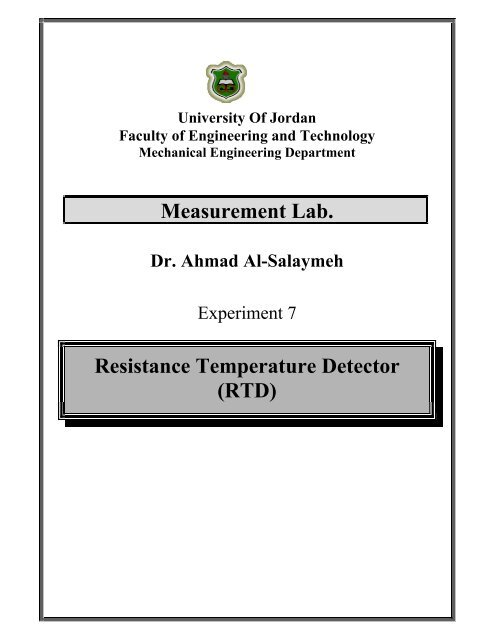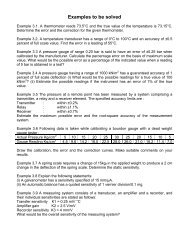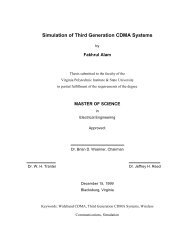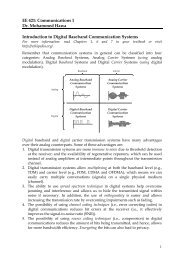Measurement Lab. Resistance Temperature Detector (RTD) - FET
Measurement Lab. Resistance Temperature Detector (RTD) - FET
Measurement Lab. Resistance Temperature Detector (RTD) - FET
Create successful ePaper yourself
Turn your PDF publications into a flip-book with our unique Google optimized e-Paper software.
University Of JordanFaculty of Engineering and TechnologyMechanical Engineering Department<strong>Measurement</strong> <strong>Lab</strong>.Dr. Ahmad Al-SalaymehExperiment 7<strong>Resistance</strong> <strong>Temperature</strong> <strong>Detector</strong>(<strong>RTD</strong>)
Objectives<strong>RTD</strong> (<strong>Resistance</strong> <strong>Temperature</strong> <strong>Detector</strong>)Upon completion of the study and laboratory experimental measurements, the student will beable to:1. Describe the materials and their temperature coefficients used in <strong>RTD</strong> devices.2. Describe how <strong>RTD</strong> elements are used for the measurement of temperature.3. Describe the overall characteristics and construction of <strong>RTD</strong> devices.4. Describe the use of the <strong>RTD</strong> sensor in a bridge circuit.Theory<strong>Resistance</strong> temperature detector (<strong>RTD</strong>) is another temperature sensing transducer which can beused to measure high temperatures’ basic physical property of a metal is that its electricalresistivity changes with temperature. All <strong>RTD</strong>'s are based on this principle. The heart of the<strong>RTD</strong> is the resistance element. <strong>RTD</strong> has a positive coefficient, i.e, when the temperature of the<strong>RTD</strong> increases, its resistance also increases. Several varieties of semi-supported wire-woundfully supported bifilar wound glass, and thin film type elements. the picture below shows severaltypes of <strong>RTD</strong>`s.Through years of experience, the characteristics of various metals and their alloys have beenlearned, and their temperature vs. resistance relationships are available in look-up tables. Somemetals have a very predictable change of resistance for a given change of temperature; these arethe metals that are most commonly chosen for fabricating an <strong>RTD</strong>. See figure (1). A precisionresistor is made from one of these metals to a nominal ohmic value at a specified temperature.By measuring its resistance at some unknown temperature and comparing this value to theresistor's nominal value, the change in resistance is determined. Because the temperature vs.resistance characteristics are also known, the change in temperature from the point initiallyspecified can be calculated. We now have a practical temperature sensor, which in its bare form(the resistor) is commonly referred to as a resistance element.
Nominal <strong>Resistance</strong>Nominal resistance is the pre-specified resistance value at a given temperature. Most standards,including IEC-751, use zero as their reference point because it is easy to reproduce. TheInternational Electrotechnical Commission (IEC) specifies the standard based on 100.00 Ohms at0 o C, but other nominal resistances are quite common. Among the advantages that thin filmtechnology has brought to the industry are small, economical elements with nominal resistancesof 500, 1000, and even 2000Ohms.For some types of <strong>RTD</strong>'s, there are also equations that give you the temperature from a givenresistance. This information has made it possible for instrument manufacturers to providestandard readout and control devices that are compatible with some of the more widely acceptedtypes of <strong>RTD</strong>'s.The heart of a <strong>RTD</strong> sensor is an element which is generally made of wire wond on a ceramiccore. The element is encased in a metal sheath probe which provides good heat transfer as wellas protection against moisture. The sheath is generally mades of stainless steel or some specialmetal alloy which can withstand high temperaures. <strong>RTD</strong> elements are usually made of platinum.Some <strong>RTD</strong>s have been made using nickel, copper ,iron or tungsten. The elemente`s resistance,usually calibrated at zero degrees C, will increase as the temperature rises. The <strong>RTD</strong> resistanceincreases by a factor of nearly two. If the element is placed in a wheatstone bridge circuit asshown in figure (2), the bridge would exhibit an imbalance as the element`s resistance increasedwith temperature.
Fig(2) <strong>RTD</strong> Sensor in Bridge CircuitThe <strong>RTD</strong> elements have the advantage that they can be used in high temperature applications.Although the <strong>RTD</strong> sensing element can be constructed of nickel, copper, tungsten or nickel-iron,the most useful metals platinum. Platinum can be highly refined. It resists contamination, it ismechanically and electrically stable and has a linear resistance versus temperature because ofthis linearity, and the meter calibration is directly correlated to the resistance changes.PLATINUM <strong>RTD</strong>The usual nominal resistance of platinum <strong>RTD</strong>s is 100ohms at 0° C. Unfortunately, standardsare not identical worldwide, which presents a problem when a <strong>RTD</strong> built to one standard is usedwith an instrument designed to a different standard. In addition, manufactured tolerances mustbe considered. Not only do they vary with the manufacturer and the standard, but the tolerancesare also affected by the manufacturing process itself.
GAYESCO offers platinum <strong>RTD</strong>s to all standards; the DIN and American standards the mostavailable. Our normal tolerance is 0.1% of the reading. The following table delineates the mostcommon standards.<strong>Temperature</strong> measurements are performed almost exclusively with direct current the <strong>RTD</strong> ismost often used in conjunction with external bridge circuitry. The degree of unbalance of abridge becomes a measure of the environmental temperature in which the <strong>RTD</strong> probe is placed.The outputs of the meter at TP46 and TP47 can feed a bridge amplifier for more sensitivemeasurements.The <strong>RTD</strong> in its commercial form is a temperature sensor of unequaled accuracy, stability andsensitivity. Performance approaching laboratory standards can be achieved in the most difficultenvironments.<strong>RTD</strong>SPECIFICATIONSEight salient parameters must be addressed for every <strong>RTD</strong> application to ensure the desiredperformance. Many will be specified by the manufacturer of the instrument to which the <strong>RTD</strong>will be connected. If it is a custom circuit or special OEM application, the designers must makeall the decisions. The four specifications dictated by the instrumentation or circuitry are: sensormaterial, temperature coefficient, nominal resistance, and, to some extent, wiring configuration.Sensor Material several metals are quite common for use in <strong>RTD</strong>'s, and the purity of the metal aswell as the element construction affects its characteristics. Platinum is by far the most popular
due to its near linearity with temperature, wide temperature operating range, and superior longtermstability. Other materials are nickel, copper, balco (an iron-nickel alloy), tungsten, andiridium. Most of these are being replaced with platinum sensors, which are becoming morecompetitive in price through the wide use of thin film-type resistance elements that require onlya very small amount of platinum as compared to a wire-wound element.<strong>Temperature</strong> CoefficientThe temperature coefficient (TC) or alpha (α) of an <strong>RTD</strong> is a physical and electrical property ofthe metal alloy and the method by which the element was fabricated. The alpha describes theaverage resistance change per unit temperature from the ice point to the boiling point of water.(alpha is the percent change in resistance that takes place with each degree rise intemperature(C)). Various organizations have adopted a number of different α`s as their standards. The α value is multiplied by the resistance value at zero degrees, and then by the temperaturerise plus the original resistance. This relationship is shown in equation (1).R t2 = R t1 (1+ α ΔT)Where :R t2 is the new resistance.R t1 is the initial resistance at the reference temperature,t1.ΔT is the change in temperature,t2-t1.Wiring ConfigurationThe wiring configuration is the last of those parameters typically specified by the instrumentmanufacturer, although the system designer does have some control based on the application. An<strong>RTD</strong> is inherently a 2-wire device, but lead wire resistance can drastically reduce the accuracy ofthe measurement by adding additional, uncompensated resistance into your system. Mostapplications therefore add a third wire to help the circuit compensate for lead wire resistance, andthus provide a truer indication of the measured temperature.Four-wire <strong>RTD</strong>'s provide slightly better compensation, but are generally found only in laboratoryequipment and other areas where high accuracy is required.Two other parameters are more application dependent the temperature range of the application;and, the accuracy.<strong>Temperature</strong> RangeAccording to the ASTM, platinum <strong>RTD</strong>'s can measure temperatures from -200 o C to 650 o C. (IECsays -200 o C to 850 o C).You must consider the temperature limitations of all the materials involved, where they areapplied, and the temperatures to which each will be exposed.A few quick examples to illustrate this point:TFE Teflon should not be used for wire insulation if it will be exposed to temperatures above200 o C (250 o C for some).Moisture proof seals are commonly made with various types of epoxy that generally have limitsbelow that of the Teflon insulation.
Many wire insulating materials become brittle at subzero temperatures and therefore should notbe used for cryogenic work. So state the intended temperature range right up front and let theapplications engineer assist you, especially since it may affect the materials chosen for internalconstruction of the probe.AccuracyYou are probably wondering why accuracy was not the first topic covered, because <strong>RTD</strong>'s aregenerally known for their high degree of accuracy and it is typically one of the firstspecifications laid out. Well, the subject is not quite that simple, and it requires a bit ofdiscussion. First, we must establish the difference between accuracy, precision, and repeatability.In the case of temperature, accuracy is commonly defined as how closely the sensor indicates thetrue temperature being measured, or in a more practical sense, how closely the resistance of the<strong>RTD</strong> matches the tabulated or calculated resistance of that type <strong>RTD</strong> at that given temperature.Precision, on the other hand, is not concerned with how well the <strong>RTD</strong>'s resistance matches theresistance from a look-up table, but rather with how well it matches the resistance of other <strong>RTD</strong>'ssubjected to that temperature. Precision generally refers to a group of sensors, and if the grouphas good precision at several temperatures, we can also say that they are well matched. This isimportant when interchangeability is a concern, as well as in the measurement of temperaturegradients. Repeatability can best be described as the sensor's ability to reproduce its previousreadings at a given temperature.Our final two parameters are application dependent and vary from the specification of a bareresistance element to a large industrial assembly with thermowells, connection heads, andpossibly field -mounted transmitters. We will discuss only the most basic areas: physicaldimensions and size restrictions, and material compatibility.Material CompatibilityMost people specifying <strong>RTD</strong> probes have to pay attention only to the chemical compatibility thatwill prevent corrosion. This is generally straightforward and guidelines can be taken from othermaterials used in the system in which the <strong>RTD</strong> will be installed. If the piping system isconstructed of 316 S.S., then the probe probably should be also. But always check a corrosionguide for corrosion rates and material recommendations if you have the slightest doubt.For applications involving thermowells, the thermowell will carry the burden of corrosionprotection. However, be sure to protect the connecting wires and any terminals or plugs frompossible corrosion caused by splash or corrosives in the atmosphere.Applications of <strong>Resistance</strong> <strong>Temperature</strong> <strong>Detector</strong>s• Air conditioning and refrigeration servicing• Food Processing• Stoves and grills• Textile production• Plastics processing• Petrochemical processing• Micro electronics• Air, gas and liquid temperature measurement• Exhaust gas temperature measurement
When to use <strong>Resistance</strong> <strong>Temperature</strong> <strong>Detector</strong>s• When accuracy and stability are a requirement of the customer’s specification.• When accuracy must extend over a wide temperature range.• When area, rather than point sensing improves control.• When a high degree of standardisation is desirable.Advantages of <strong>Resistance</strong> <strong>Temperature</strong> <strong>Detector</strong>s• Linear over wide operating range• Wide temperature operating range• High temperature operating range• Interchangeability over wide range• Good stability at high temperatureDisadvantages of <strong>Resistance</strong> <strong>Temperature</strong> <strong>Detector</strong>s• Low sensitivity• Higher cost than thermocouples• No point sensing• Affected by shock and vibration · Requires three or four-wire operation<strong>Resistance</strong> <strong>Temperature</strong> <strong>Detector</strong> or Thermocouple:Both thermocouples and <strong>RTD</strong>’s are useful sensors for determining process temperature. <strong>RTD</strong>’sprovide higher accuracy than thermocouples in their temperature range because platinum is amore stable material than are most thermocouple materials. <strong>RTD</strong> also uses standardinstrumentation wire to connect to the measurement or control equipment.Thermocouples are generally less expensive than <strong>RTD</strong>s, they are more durable in high vibrationor mechanical shock applications and are usable to higher temperatures. Thermocouples can bemade smaller in size than most <strong>RTD</strong>’s so they can be formed to fit a particular application.
SUMMARYThere are quite a few things to be considered when specifying an <strong>RTD</strong> probe or even resistanceelements. But it's just a matter of applying a bit of common sense and using information from theapplication environment to set down a clear set of requirements. And if there is something youare uncertain about, get your background information together and call that applicationsengineer.<strong>Lab</strong>oratory ExperimentationTest And Measurments:The experimental circuit is located on panel SIP380-1 in setion G. figure 13-3 shows the ciruitdiagram of the test circuit.Figure 13-3 Thermistor /<strong>RTD</strong> CircuitMaterials Requied :Master builder (S300B)Insertion Panel with <strong>RTD</strong> sensor (SIP380-1)Digital multimeter (DMM)Thermometer ,0 o to 100 o C or 32 o to 212 o FThe experimental circuit is located on panel SIP380-1. Fig (2) shows the circuit diagram of thetest circuit.
Experimental Procedures:The <strong>RTD</strong> sensor is connected to the input of transistor amplifier. The current through theamplifier is initially adjusted to a low value and the current is then observed as the <strong>RTD</strong> sensor isheated.1- With switch SWg-4 open, measure the resistance of the <strong>RTD</strong> sensor at room temperature.Measure across TP49 and TP50. Allow time for the resistance value to stabilize.<strong>RTD</strong> =Ώ2- Turn on the 10Ώ heater resister by closing switch SWG-1. Allow 2 or 3 minutes for the heaterto warm p. place the <strong>RTD</strong> element next to the heater and continue to measure the resistance ofthe <strong>RTD</strong> element. What is the value of the resistance after one minute of heating the element.Ώ3-Allow the <strong>RTD</strong> sensor to cool again. Close switch SWg-4, which connects the <strong>RTD</strong> to the baseof the amplifier. The sensor will be used to control the current through the amplifier. Adjust thepower supply to 10VDC and set R1 fully clockwise (most resistance). Connect the 1 mA meter(note polarity) to TP51 and TP52. Close switch SWg-3 and adjust R1 so that the meter current(collector) reads near zero. With a DMM, measure the base bias voltage (Vb) between TP49 andTP50.Vb =VDC4-When the sensor is again placed next to the heater resistor, the sensor`s resistance(increases/decreases)and the voltage at the base(increases/ decreases).5- Heat the <strong>RTD</strong> element for one minute and record the folowing:Collector (meter) current, Ic= mABase voltage, Vb= VDCCollector voltage, Vc= VDC6-DC gain is determined from:A DC = ΔVcΔVbWhere ΔV is the change in voltage due to a rise in temperature. Therefore, A DC = .7-Did the measurements verify that a rise in temperature causes an increase in the resistance ofthe <strong>RTD</strong> sensor .8- Use R of room temperature above 0 o o C.9-What is the temperature next to the heater coil.Use the results from steps 1 and 2 and an α of 0.00392 to calculate this temperature.o C10-The temperature difference between the heater and room temperature iso C
Review Quistions:1. How does the <strong>RTD</strong> differ from the thermistor and the thermocouple.2-Is the temperature coefficient of an <strong>RTD</strong> positive or negative.3- Assume that at 22 o C, the alpha of a 100Ω <strong>RTD</strong> sensor is 0.00392 and the <strong>RTD</strong> is placed in anenvironment of 72 o C. What is its new resistance o show your calculations.4- What is the reference temperature which the resistance of most <strong>RTD</strong>s is specified.5- Discuss the meaning of the term alpha as applied to a <strong>RTD</strong> sensor.6- Why does the 1.0 mA meter in the <strong>RTD</strong> controlled amplifier read in a positive direction.7- How could the experimental circuit be used to measure an unknown temperature.
















